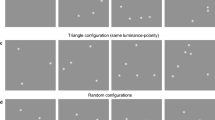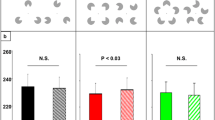Abstract
The present paper considers the relation between the shape of a triangle and probability of its recognition. An effect of triangle size on perception of its shape is examined in the first experiment. In the second the loci of eye fixations during triangle recognition task are recorded and analysed. A simulation model of the recognition process is proposed. The model is based on two main assumptions: 1. an accuracy of shape processing is related to the cortical magnification factor, 2. a subject's response depends on actual position of eye fixation. The validity of the model is verified by comparing the theoretical and experimental response distributions. Some psychophysiological implications are then discussed.
Similar content being viewed by others
References
Attneave F (1954) Some informational aspects of visual perception. Psychol Rev 61:183–193
Attneave F, Arnoult MD (1956) The quantitative study on shape and pattern perception. Psychol Bull 53:452–471
Barlow HB, Reeves BC (1979) The versatility and absolute efficiency of detecting mirror symmetry in random dot displays. Vision Res 19:783–793
Bedell HE, Barbeito R, Aitsebaomo PA (1984) The precision of oculocentric direction and its role in the stability of fixation. Vision Res 24:1157–1161
Blum H (1973) Biological shape and visual science, part 1. J Theor Biol 38:205–287
Cavanagh P (1978) Size and position invariance in the visual system. Perception 7:167–177
Cavanagh P (1981) Size invariance: reply to Schwartz. Perception 10:469–474
Cavanagh P (1982) Functional size invariance is not provided by the cortical magnification factor. Vision Res 22:1409–1412
Daniel PM, Whitteridge D (1961) The representation of the visual field on the cerebral cortex in monkeys. J Physiol 159:203–221
Dow BM, Snyder AZ, Vautin RG, Bauer R (1981) Magnification factor and receptive field size in foveal striate cortex of the monkey. Exp Brain Res 44:213–228
Finney DJ (1952) Probit analysis. Cambridge University Press, Cambridge
Foster DH (1982) Analysis of discrete internal representations of visual pattern stimuli. In: Beck J (ed) Organization and representation in perception. Lawrence Erlbaum Associates, Hillsdale, NJ, pp 319–341
Guld C, Bertulis A (1976) Representation of fovca in the striate cortex of vervet monkey, cercopithecus aethiops pygerythrus. Vision Res 16:629–631
Hitchcock PF, Hickey TL (1980) Ocular dominance columns: evidence for their presence in humans. Brain Res 182:176–179
Horton JC, Hubel DH (1980) Cytochrome oxidase stain preferentially labels intersection of ocular dominance and vertical orientation columns in macaque striate cortex. Soc Neurosci 6:315 (abstr)
Hubel DH, Wiesel TN (1974) Uniformity of monkey striate cortex: a parallel relationship between field size, scatter, and magnification factor. J Comp Neurol 158:295–306
Jenkins B (1983) Component processes in the perception of bilaterally symmetric dot textures. Percept Psychophys 34:433–440
Julesz B (1971) Foundations of cyclopean perception. University of Chicago Press, Chicago, pp 127–133
Letelier JC, Varcla F (1984) Why the cortical magnification factor in rhesus is isotropic. Vision Res 24:1091–1095
Levi DM, Klein SA, Aitsebaomo AP (1985) Vernier acuity, crowding and cortical magnification. Vision Res 25:963–977
Pizlo Z, Gradus-Pizlo IA (1986) Simulation model of human shape recognition. Invest Ophthalmol Vis Sci [Suppl] 27:343
Pizlo Z, Szczechura J (1984) The role of eye movements in shape recognition, Perception 13:A44
Pizlo Z, Szczechura J (1987) Simulation model of judgements of asymmetry of a triangle based on eye fixations. In: O'Regan JK, Levy-Schoen A (eds) Eye movements: from physiology to cognition. Elsevier-North-Holland, Amsterdam, New York, pp 376–377
Pizlo Z, Tarnecki R (1987a) The effect of figure position on shape recognition. Invest Ophthalmol Vis Sci [Suppl] 28:101
Pizlo Z, Tarnecki R (1987b) The importance of eye movements in triangle shape discrimination. In: Lüer G, Lass U (eds) Fourth European Conference on Eye Movements, Vol 1: Proceedings. Hogrefe, Lewiston, pp 49–52
Rattle JD (1969) Effect of target size on monocular fixation. Optical Acta 16:183–192
Rovamo J, Raninen A (1984) Critical flicker frequency and M-scaling of stimulus size and retinal illuminance. Vision Res 24:1127–1131
Rovamo J, Virsu V (1979) An estimation and application of the human cortical magnification factor. Exp Brain Res 37:495–510
Rovamo J, Virsu V, Nasanen R (1978) Cortical magnification factor predicts the photopic contrast sensitivity of peripheral vision. Nature 271:54–56
Sagi D, Julesz B (1985) “Where” and “what” in vision. Science 228:1217–1219
Sakitt B (1982) Why the cortical magnification factor in rhesus can not be isotropic. Vision Res 22:417–421
Sansbury RV, Skavenski AA, Haddad GM, Steinman RM (1973) Normal foxation of eccentric targets. J Opt Soc Am 63:612–614
Schlingensiepen K-H, Campbell FW, Legge GE, Walker TD (1986) The importance of eye movements in the analysis of simple patterns. Vision Res 26:1111–1117
Schwartz EL (1980a) A quantitative model of the functional architecture of human striate cortex with application to visual illusion and cortical texture analysis. Biol Cybern 37:63–76
Schwartz DL (1980b) Computational anatomy and functional architecture of striate cortex: a spatial mapping approach to perceptual coding. Vision Res 20:645–669
Schwartz EL (1983) Cortical mapping and perceptual invariance: a reply to Cavanagh. Vision Res 23:831–835
Steinman RM (1965) Effect of target size, luminance and color on monocular fixation. J Opt Soc Am 55:1158–1165
Steinman RM (1986) Eye movement. Vision Res 26:389–1400
Talbot SA, Marshall WH (1941) Physiological studies on neural mechanisms of visual localization and discrimination. Am J Opthalmol 24:1255–1264
Tootel RBH, Silverman MS, Switkes E, De Valois RL (1982) Deoxyglucose analysis of retinotopic organization in primate striate cortex. Science 218:902–904
Van Essen DC, Newsome WT, Maunsell JHR (1984) The visual field representation in striate cortex of the macaque monkey: asymmetries, anisotropies, and individual variability. Vision Res 24:429–448
Virsu V, Rovamo J (1979) Visual resolution, contrast sensitivity, and cortical magnification factor. Exp Brain Res 37:475–494
Virsu V, Rovamo J, Laurinen P, Nasanen R (1982) Temporal contrast sensitivity and cortical magnification. Vision Res 22:1211–1217
Vitz PC, Todd TC (1971) A model of the perception of simple geometric figures. Psychol Rev 78:207–228
Warrington EK (1985) Agnosia: the impairment of object recognition. In: Frederiks JAJ (ed) Handbook of clinical neurology. 1(45). Elsevier, Amsterdam New York, pp 333–349
Wertheim T (1894) Über die indirekte Sehschärfe. Z Psychol Physiol Sinnesorg 7:172–189
Weymouth FW, Hines DC, Acres LH, Raaf JE, Wheeler MC (1928) Visual acuity within the area centralis and its relation to eye movements and fixation. Am J Ophthalmol 11:947–960
Author information
Authors and Affiliations
Additional information
A partial report of this research was given at the Annual Meeting of the Association for Research in Vision and Ophthalmology (Pizlo and Gradus-Pizlo 1986)
Rights and permissions
About this article
Cite this article
Pizlo, Z. Physiology based simulation model of triangle shape recognition. Biol. Cybern. 58, 51–62 (1988). https://doi.org/10.1007/BF00363955
Received:
Accepted:
Issue Date:
DOI: https://doi.org/10.1007/BF00363955




